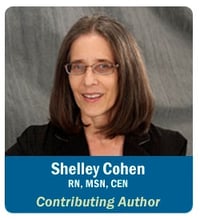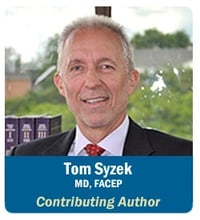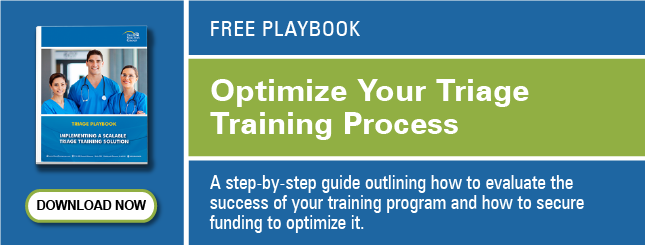 When a patient presents with chest pain or chest-related symptoms, the role of the triage nurse is to critically evaluate the relationship of risk factors to outcome potentials to make the best triage decisions. The more risk factors a patient has, the greater the triage nurse’s concern for a potential high-risk scenario. In this blog, we will propose several triage questions for chest pain and consider several serious concerns that can prompt a patient to present with chest-related complaints, not all of which involve the heart:
When a patient presents with chest pain or chest-related symptoms, the role of the triage nurse is to critically evaluate the relationship of risk factors to outcome potentials to make the best triage decisions. The more risk factors a patient has, the greater the triage nurse’s concern for a potential high-risk scenario. In this blog, we will propose several triage questions for chest pain and consider several serious concerns that can prompt a patient to present with chest-related complaints, not all of which involve the heart:
- Acute coronary syndrome
- Pulmonary embolism
- Pneumothorax
- Thoracic aortic aneurysm
- Malfunctioning pacemaker
Design a Triage Training Program that results in measurable change. For implementation best practices:
Acute Coronary Syndrome (ACS)
One of the greatest impacts on triage processes has been the ability to rapidly identify patients at risk for STEMI (ST elevation myocardial infarction) and other acute coronary syndromes. Adults over 30 years of age with non-traumatic chest pain should prompt the triage nurse to consider the possibility of ACS.
There are distinct risk factors that position a patient for a greater risk of ACS. These risk factors are well known to the public, as they have been taught for more than 20 years to all age demographics by the American Heart Association.
- Hypertension: Increases workload on the heart
- Age: 82% of patients who die from CAD are 65 or older
- Male Gender: Greater risk for an MI; occurs at younger age than women
- Heredity & Race: African-American, Mexican-Americans, and Native-Americans
- Smoker: 2 to 4 times the risk of developing heart disease
- ↑Cholesterol: Total cholesterol should be < 200; triglycerides < 150
- Sedentary Lifestyle: The more vigorous the activity, the greater the benefit
- Obesity/Weight: Increases blood pressure and workload of heart
- Diabetes: 65% of diabetics die from heart or blood vessel disease
Questions aimed at identifying the patient with possible ACS:
- Where is your pain? (location)
- Does it go anywhere else? (radiation)
- When did it start? (onset)
- How long has it lasted? (duration)
- How bad is it? (severity on pain scale)
- Does anything make it better or worse?
- Have you taken any medication to relieve it?
- Do you have any of the following: shortness of breath, weakness, fatigue, cold sweat, dizziness, nausea, indigestion?
- Do you have any of the following risk factors?
- Prior history of heart disease
- Hypertension
- Family history of ACS
- Smoking history
- High cholesterol
- Diabetes
While recognizing risk factors in the presenting patient with chest pain/dyspnea, the triage nurse must also consider the following:
- Absence of chest pain does not imply absence of a cardiac event.
- Not all patients present with classic or typical signs/symptom – especially the elderly, diabetic or female patient.
- Don’t delay obtaining an ECG.
Pulmonary Embolism
 Pulmonary embolism (PE) most commonly originates in the calf; it occurs as a complication of venous stasis and other factors. The presence of embolus in one or more arteries of the lung creates a scenario of decreased cardiac output. Even though the clinical symptoms and signs of pulmonary embolism are very non-specific, research and retrospective review from patient autopsies reveal patients who are at the greatest risk for developing PE.
Pulmonary embolism (PE) most commonly originates in the calf; it occurs as a complication of venous stasis and other factors. The presence of embolus in one or more arteries of the lung creates a scenario of decreased cardiac output. Even though the clinical symptoms and signs of pulmonary embolism are very non-specific, research and retrospective review from patient autopsies reveal patients who are at the greatest risk for developing PE.
Questions aimed at identifying the patient with a possible PE (ask the following questions in addition to the questions above for possible ACS):
- Did you have sudden onset of shortness of breath either at rest or when active?
- Does your chest pain tend to worsen with exertion and is it unrelieved by rest?
- Are you coughing up any blood?
- Do you have any of the following risk factors:
- Immobilization
- Travel of 4 hours or more in the past month
- Surgery within the last 3 months
- Malignancy, especially lung cancer
- Current or past history of thrombophlebitis
- Trauma to the lower extremities and pelvis during the past 3 months
- Smoking
- Central venous instrumentation within the past 3 months
- Stroke, paresis, or paralysis
- Prior pulmonary embolism
- Heart failure
- Chronic obstructive pulmonary diseases
Don’t fall into common triage pitfalls that result in poor patient outcomes related to PE:
- Assuming that unexplained dyspnea is due to anxiety or hyperventilation
- Failing to identify patients with risk factors for PE
- Failing to critically think through the relationship of DVT to PE risk
- Assuming that pleuritic chest pain with a normal ECG is musculoskeletal pain
Spontaneous Pneumothorax
 Air or gas can enter the pleural cavity through a variety of mechanisms; some are related to injury, others occur spontaneously. Its presence will interfere with oxygenation and at times ventilation; the impact will be dependent on the size of the disruption. The patient does not always have an underlying lung disease that creates the pneumothorax. In the absence of any underlying clinical causes in the presence of pneumothorax, this patient is known as primary spontaneous pneumothorax (PSP). It is usually the rupture of a bleb or bullae that causes the spontaneous pneumothorax.
Air or gas can enter the pleural cavity through a variety of mechanisms; some are related to injury, others occur spontaneously. Its presence will interfere with oxygenation and at times ventilation; the impact will be dependent on the size of the disruption. The patient does not always have an underlying lung disease that creates the pneumothorax. In the absence of any underlying clinical causes in the presence of pneumothorax, this patient is known as primary spontaneous pneumothorax (PSP). It is usually the rupture of a bleb or bullae that causes the spontaneous pneumothorax.
A patient with underlying pulmonary pathology (SSP - secondary spontaneous pneumothorax) from lung disease has distended and/or damaged alveoli through which air can travel and enter the pleural space.
Questions aimed at identifying the patient with a possible spontaneous pneumothorax:
- Have you had a prior pneumothorax?
- Do you have a smoking history?
- Do you have Marfan syndrome?
- Do you have any lung disease? (COPD, asthma, HIV with lung infection, TB, sarcoidosis, or cancer)
Thoracic Aortic Aneurysm
An aneurysm is a localized or diffuse dilation of an artery with a diameter that is at least 50% greater than the artery’s normal size. Although most aortic aneurysms occur in the abdomen, deaths due to thoracic aortic dissection (TAD) are twice as common.
Questions aimed at identifying the patient with a possible dissecting TAD:
- Is your chest pain sudden onset?
- Does the pain radiate to the neck, back, flank or abdomen?
- Is the pain sharp or tearing in quality?
- Have you fainted (syncope)?
- Do you have a family history of thoracic aortic dissection?
- Do you have an inherited connective tissue disorder? (Marfan or Ehlers-Danlos syndrome)
- Do you have hypertension or atherosclerosis?
- Do you have a smoking history?
- Have you used cocaine or other stimulants?
- Have you had any recent procedures on your heart or arteries (angiography, stents)?
Pacemaker Malfunction
Approximately 200,000 pacemaker devices are implanted in patients in the United States each year. Although the technology related to pacemakers continues to advance, malfunctions may still occur. There are many causes for malfunction or failure of a pacemaker. The extent of the pacemaker malfunction and how well the patient does or does not compensate will impact the severity of the potential for demise. An additional consideration for the triage nurse is the length of time the patient has been experiencing symptoms.
An immediate ECG is always indicated to ensure that the patient is not having ST or other cardiac issues aside from the pacemaker. A patient who has had an uneventful course related to their pacemaker often discounts the pacemaker as a source of symptoms; a delay in care for what started out as simply a “dizzy spell” can lead to major perfusion concerns in a short period of time.
Questions aimed at identifying the patient with a possible malfunctioning pacemaker:
- Do you have a pacemaker?
- When did the symptoms start? (onset)
- How long have your symptoms lasted? (duration)
- Did you have syncope (fainting), dizziness or lightheadedness?
- Have you noticed a low or high heart rate? (bradycardia, tachycardia)
- Has your blood pressure been unusually low? (hypotension)
- Do you have shortness of breath?
- Have you been sweaty or pale?
- Have you been feeling tired or weak?
- Have you felt any skipped or extra heartbeats? (palpitations)
More than 7 million patients present to an emergency department each year with chest pain and related symptoms (this does not take into account the unknown volume of patients with these complaints who present to urgent care facilities). With this high volume of patients, it is important for the triage nurse to ask the key questions that will identify patients at higher risk for serious underlying causes of their chest pain.
Related Content:



